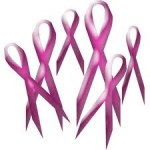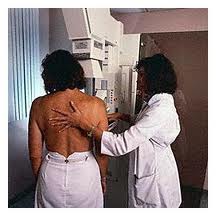 A recent study published in the Journal of the American Medical Association (JAMA) has concluded that about two-thirds of women who undergo a lumpectomy to treat breast cancer receive radiation therapy for longer than necessary. Radiation is used after a lumpectomy to reduce the likelihood of cancer returning and to increase survival rates. Traditional radiation treatment following lumpectomies typically lasts five to seven weeks. However, the JAMA study, along with various other tests and studies indicate that a shorter, more intense three to four week treatment of radiation is just as effective. Studies have also found that women prefer to receive shorter courses of radiation treatment, and that shorter treatment is less expensive. Considering that about 60% to 75% of women with breast cancer receive lumpectomies, there is significant potential for increased patient satisfaction and reduced costs by offering shorter radiation therapy. Unfortunately, years of ingrained practice and hesitancy to change a course of treatment used for years may slow the rate in which shorter radiation therapy is used on lumpectomy patients. However, due to this study and others like it, this course of treatment will likely become more common over time. Source: Kolata, Gina. “Long Radiation Treatments Called Unnecessary in Many Breast Cancer Cases.” The New York Times. 10 December 2014.
A recent study published in the Journal of the American Medical Association (JAMA) has concluded that about two-thirds of women who undergo a lumpectomy to treat breast cancer receive radiation therapy for longer than necessary. Radiation is used after a lumpectomy to reduce the likelihood of cancer returning and to increase survival rates. Traditional radiation treatment following lumpectomies typically lasts five to seven weeks. However, the JAMA study, along with various other tests and studies indicate that a shorter, more intense three to four week treatment of radiation is just as effective. Studies have also found that women prefer to receive shorter courses of radiation treatment, and that shorter treatment is less expensive. Considering that about 60% to 75% of women with breast cancer receive lumpectomies, there is significant potential for increased patient satisfaction and reduced costs by offering shorter radiation therapy. Unfortunately, years of ingrained practice and hesitancy to change a course of treatment used for years may slow the rate in which shorter radiation therapy is used on lumpectomy patients. However, due to this study and others like it, this course of treatment will likely become more common over time. Source: Kolata, Gina. “Long Radiation Treatments Called Unnecessary in Many Breast Cancer Cases.” The New York Times. 10 December 2014.
 October is Breast Cancer Awareness Month, and, in the city of Chicago there are many ways to get involved. Classes, races, walks, performances, and seminars are scattered throughout the month of October. If you live in the Chicagoland area and want to honor breast cancer survivors, learn more, or raise awareness and funding to continue combating this cancer, be sure to check Eventbrite’s Breast Cancer Conferences calendar to see what's going on in your area. Your Northwestern community is also conducting symposiums and meetings on breast cancer this month.
October is Breast Cancer Awareness Month, and, in the city of Chicago there are many ways to get involved. Classes, races, walks, performances, and seminars are scattered throughout the month of October. If you live in the Chicagoland area and want to honor breast cancer survivors, learn more, or raise awareness and funding to continue combating this cancer, be sure to check Eventbrite’s Breast Cancer Conferences calendar to see what's going on in your area. Your Northwestern community is also conducting symposiums and meetings on breast cancer this month.
If your schedule is too full for events, taking the PLEDGE is a simple way to educate yourself and others about breast cancer. The PLEDGE involves:
- Prevention—ask your doctor and identify ways to reduce your risk of breast cancer
- Learning—do your own research to increase your knowledge
- Examination—get screened for breast cancer
- Density—speak with your doctor about your breasts’ density to determine which screening approach is appropriate
- Genetics—discuss your family history of breast cancer with your doctor to analyze your potential level of risk
- Educate—teach others to take the PLEDGE
Over the course of a lifetime, a woman has a 12.3% risk of being diagnosed with breast cancer. Speak with your doctor, educate yourself, and educate others.
Source: ABC News
 A recent article in the Journal of Clinical Oncology recommends to oncologists that all patients with invasive breast cancer, including recurrent disease, should be tested for HER 2 status and these tests should adhere to specific criteria to define positive, equivocal, and negative results.
A recent article in the Journal of Clinical Oncology recommends to oncologists that all patients with invasive breast cancer, including recurrent disease, should be tested for HER 2 status and these tests should adhere to specific criteria to define positive, equivocal, and negative results.
The American Society of Clinical Oncology (ASCO) and the College of American Pathologists (CAP) have released updated recommendations for HER2 testing in breast cancer. The new guideline endorses HER2 testing for every primary, recurrent, and metastatic tumor. Additionally, the report advocates retesting in patients who previously tested HER2-negative but demonstrate clinical behavior suggestive of HER2-positive or triple-negative disease at the time of recurrence.
| HER2 is a protein involved in normal cell growth. It is found on some types of cancer cells, including breast and ovarian. Cancer cells removed from the body may be tested for the presence of HER2/neu to help decide the best type of treatment. HER2/neu stands for human epidermal growth factor receptor 2. The accurate identification of patients with HER2-positive breast cancer remains an area of high interest, since HER2-targeted therapies can substantially improve their survival. |
The first test ideally should be performed on a core biopsy specimen from a patient with newly diagnosed breast cancer. If there is discordance, a section of the tumor from the excisional specimen should be tested. If this test is negative and concerns remain, the updated guideline recommends retesting in a different block from the patient’s tumor. If all three tests are negative, no additional testing is recommended
This is an update of guidelines previously published in 2007. The update does not represent a dramatic overhaul but instead clarifies test criteria, definitions, and processes, said Eric Weiner, MD, a breast cancer specialist in the Susan F Smith Center for Women’s Cancers at Dana Farber Cancer Institute. “What this guideline states is that if more than 10% of the tumor meets the criteria for HER2 positivity, than it is called HER2 positive.”
Primary Source: Journal of Clinical Oncology
 There’s a new “toy” in the surgical wing at the UC Irvine Medical Center that’s causing surgical oncologists to perform 56% less duplicate breast cancer surgeries. It’s called MarginProbe, and it detects whether surgeons have removed all of a woman’s breast cancer cells during surgery, reducing the necessity of a second operation. This sterile, handheld device sends electromagnetic signals to the bodily tissues surrounding a surgical incision, which are then transmitted and analyzed to determine whether any unhealthy tissue remains in the breast.
There’s a new “toy” in the surgical wing at the UC Irvine Medical Center that’s causing surgical oncologists to perform 56% less duplicate breast cancer surgeries. It’s called MarginProbe, and it detects whether surgeons have removed all of a woman’s breast cancer cells during surgery, reducing the necessity of a second operation. This sterile, handheld device sends electromagnetic signals to the bodily tissues surrounding a surgical incision, which are then transmitted and analyzed to determine whether any unhealthy tissue remains in the breast.
Before this device, 60% of lumpectomy patients were sent back to the operating room because some cancerous tissue was missed in the initial surgery. Furthermore, these patients would have had to wait up to a week before pathologists could determine whether all malignant cells were removed. Now, with MarginProbe, the tissue is analyzed instantaneously, while the patient is still in surgery, increasing the surgeon’s likelihood of eradicating the cancerous cells on the first try.
One surgical oncologist at UC Irvine, who had begun using the probe in March, said, “This new technology is a game changer for early-stage breast cancer surgery, and we’re already seeing better results!” With lumpectomies serving as the standard procedure for two-thirds of the new breast cancer cases each year, this probe is bound to make a large splash in the effective treatment “pool.” The FDA eagerly approved the MarginProbe after Dune Medical Devices developed the prototype in 2012. UC Irvine was selected to use MargineProbe in a clinical trial, which included over 660 women nationally. Well on its way to becoming a staple in the oncologist’s tool belt, the MarginProbe also promises to reduce healthcare costs by decreasing the necessity of follow-up surgeries, saving up to $6,000 per patient. This new probe will prove to be instrumental in providing high quality patient care for women afflicted with breast cancer.
Source: HealthlineNews
 Geneticists, researchers, and patients joined in celebration over last week’s unanimous Supreme Court ruling involving the BRCA1 and BRCA2 genes, colloquially referred to as the “breast cancer genes.” The Supreme Court ruled that Myriad Genetics could not patent the BRCA1 and BRCA2 sequence of genes, because patents cannot be placed on that which is created organically in nature. This decision opens the door for researchers outside of Myriad Genetics to study these genes, providing more opportunities to discover early signs of breast cancer susceptibility. Karuna Jaggar, Breast Cancer Action’s Executive Director reported that this ruling was, “a tremendous victory for women with a known or suspected inherited risk of breast cancer. Today, the Court righted a wrong and has put patients’ health before corporate profits.”
Geneticists, researchers, and patients joined in celebration over last week’s unanimous Supreme Court ruling involving the BRCA1 and BRCA2 genes, colloquially referred to as the “breast cancer genes.” The Supreme Court ruled that Myriad Genetics could not patent the BRCA1 and BRCA2 sequence of genes, because patents cannot be placed on that which is created organically in nature. This decision opens the door for researchers outside of Myriad Genetics to study these genes, providing more opportunities to discover early signs of breast cancer susceptibility. Karuna Jaggar, Breast Cancer Action’s Executive Director reported that this ruling was, “a tremendous victory for women with a known or suspected inherited risk of breast cancer. Today, the Court righted a wrong and has put patients’ health before corporate profits.”
Prior to this ruling, bio-tech conglomerate, Myriad Genetics, held patents on the BRCA1 and BRCA2 genes, monopolizing the research that can be done on these genes, which are strong indicators of susceptibility to breast cancer. Myriad had used their patents to come up with its BRACAnalysis test, which searches for specific mutations in these cancer predisposition genes. Women who show these mutations have a three to seven times greater risk of developing breast cancer. Myriad’s previously established patents on these genes gave them exclusive rights to use this genetic test on these genes. Now that the BRCA1 and BRCA2 genes are open to outside researchers, scientists can use these genes to determine increased risks of patients who may develop breast cancer, ovarian cancer, and other cancers that these genes may help indicate.
Angelina Jolie recently made headlines for deciding to voluntarily undergo a double mastectomy after learning of her own BRCA genes' mutations. Jolie had paid a high price for this test, since Myriad had a monopoly on the market, driving up the cost. So what does this mean for the average, non-Angelina Jolie woman? Well, now this test will be widely available for more women at a more affordable price (we don’t all have as deep of pockets as Jolie). This ruling will not only open the door for more opportunities for preventative screenings for breast cancer, but it will set a precedent for the scientific community to collaborate on research towards the common good.
For more information on this court ruling, please refer to this posts's sources found here and here.
 The U.S. Food and Drug Administration today approved Lymphoseek Injection, a radioactive diagnostic imaging agent that helps doctors locate lymph nodes in patients with breast cancer or melanoma who are undergoing surgery to remove tumor-draining lymph nodes.
The U.S. Food and Drug Administration today approved Lymphoseek Injection, a radioactive diagnostic imaging agent that helps doctors locate lymph nodes in patients with breast cancer or melanoma who are undergoing surgery to remove tumor-draining lymph nodes.
Lymph nodes filter lymphatic fluid that flows from the body’s tissues. This fluid may contain cancer cells, especially if the fluid drains a part of the body containing a tumor. By surgically removing and examining the lymph nodes that drain a tumor, doctors can sometimes determine if a cancer has spread.
Lymphoseek is an imaging drug that helps locate lymph nodes; it is not a cancer imaging drug. Lymphoseek is the first new drug used for lymph node mapping to be approved in more than 30 years. Other FDA-approved drugs used for lymph node mapping include sulfur colloid (1974) and isosulfan blue (1981).
“Removal and pathological examination of lymph nodes draining a primary tumor is an important diagnostic evaluation for some patients with breast cancer or melanoma,” said Shaw Chen, M.D., deputy director of the Office of Drug Evaluation IV in the FDA’s Center for Drug Evaluation and Research. “To use Lymphoseek, doctors inject the drug into the tumor area and later, using a handheld radiation detector, find lymph nodes that have taken up Lymphoseek’s radioactivity.”
Lymphoseek’s safety and effectiveness were established in two clinical trials of 332 patients with melanoma or breast cancer. All patients were injected with Lymphoseek and blue dye, another drug used to help locate lymph nodes.
Surgeons subsequently removed suspected lymph nodes for pathologic examination. Confirmed lymph nodes were examined for their content of blue dye and/or Lymphoseek. Results showed Lymphoseek and blue dye had localized most lymph nodes, although a notable number of nodes were localized only by Lymphoseek.
The most common side effects identified in clinical trials was pain or irritation at the injection site.
Lymphoseek is marketed by Navidea Biopharmaceuticals, Inc. based in Dublin, Ohio.
For more information:
FDA Approved Drugs: Questions and Answers
#
 Taking tamoxifen (Novaldex) for 10 years after primary treatment leads to a greater reduction in breast cancer recurrences and deaths than taking the drug for only 5 years according to findings from the ATLAS trial, which were presented at the San Antonio Breast Cancer Symposium.
Taking tamoxifen (Novaldex) for 10 years after primary treatment leads to a greater reduction in breast cancer recurrences and deaths than taking the drug for only 5 years according to findings from the ATLAS trial, which were presented at the San Antonio Breast Cancer Symposium.
Nearly 7,000 women with early-stage, estrogen-receptor positive breast cancer were enrolled in the trial between 1996 and 2005. After taking tamoxifen for 5 years, participants were randomly assigned to continue taking tamoxifen for another 5 years or to stop taking it. Among the women who took tamoxifen for 10 years, the risk of breast cancer returning between 10 and 14 years after starting tamoxifen was 25 percent lower than it was among women who took it for 5 years, and the risk of dying from breast cancer was nearly 30 percent lower. Interestingly, the positive difference in outcome only emerged after the 10-year mark of taking the drug, and not between 5 -9+ years.
Tamoxifen can have side effects, including hot flashes, fatigue, and an increased risk of blood clots and endometrial cancer but there was no rise in the occurrence of these side effects for the women who took the drug for the extended period. Women with a higher risk of their cancer returning long after adjuvant therapy ends, such as those whose cancers had infiltrated their lymph nodes or who had larger tumors, "will definitely be strong candidates for continuation of [tamoxifen] therapy," Dr Ravdin of the University of Texas Health Sciences Center at San Antonio, who moderated the press briefing said. But a woman at low risk of recurrence at any point "may very well rationally decide she doesn't want to take tamoxifen beyond 5 years”.
Both Pre-menopausal and Post-menopausal women could be candidates for this extended use of tamoxifen adjuvant therapy. It is important to consult with your doctor about the efficacy of this treatment for you.
~Cameron Phillips
NCI Cancer Bulletin December 12, 2012 vol 9 number 24
 Regular mammography screening can help narrow the breast cancer gap between black and white women.
Regular mammography screening can help narrow the breast cancer gap between black and white women.
Earlier studies have shown that black women in Chicago are more than twice as likely to die of breast cancer compared to white women. Black women with breast cancer reach the disease’s late stages more often than white women, and their tumors are more likely to be larger and more biologically aggressive.
But according to the study, when women of both races received regular breast cancer screening — a mammogram within two years of breast cancer diagnosis — there was no difference in the rate of how many of them presented in the disease’s later stages.
This study was conducted over six years in Chicago at Rush University Medical Center and Northwestern Memorial Hospital. It compared women who were regularly screened by mammograms with women who were only irregularly screened. This study reinforces the fact that regular screening by mammography can improve outcomes for all women.
An important finding – breast cancer diagnoses after regular screening were found (more likely) to be hormone receptive (tumors that contain receptors for estrogen and progesterone). Hormone receptive breast cancers more often lead to better survival rates because of the various treatment options that have a proven record, such as Tamoxifen and Aromatase inhibitors. This leads to suggesting that early and regular screening can inhibit development of some negative biological characteristics of breast tumors.
Sources: Rush Medical Newsletter
http://content.govdelivery.com/bulletins/gd/USCDC-5c7249
 The breast cancer rate in the UK per 100,000 women in 2010 was practically double the rate in 1971. A number of UK scientists attribute this dramatic rise in the rates to the routine exposure to toxic chemicals, which are added to personal care, beauty, and household products. However, with the introduction of regular screening in 1987, the mortality rates have dramatically declined. Proving cause and effect of environmental exposure cause is difficult, time-consuming, and expensive but the interest is growing. These chemicals are getting into women’s bodies by applying them to the skin, by inhaling them, and by eating and drinking. The report from Breast Cancer UK, a public charity, offers practical suggestions to reduce one’s exposure to these toxic chemicals:
The breast cancer rate in the UK per 100,000 women in 2010 was practically double the rate in 1971. A number of UK scientists attribute this dramatic rise in the rates to the routine exposure to toxic chemicals, which are added to personal care, beauty, and household products. However, with the introduction of regular screening in 1987, the mortality rates have dramatically declined. Proving cause and effect of environmental exposure cause is difficult, time-consuming, and expensive but the interest is growing. These chemicals are getting into women’s bodies by applying them to the skin, by inhaling them, and by eating and drinking. The report from Breast Cancer UK, a public charity, offers practical suggestions to reduce one’s exposure to these toxic chemicals:
- Read the labels on products and buy those with fewer ingredients and be aware of which chemicals may be hazardous to your health.
- Be especially careful with food and drink for babies and small children especially those with bisphenol-A (BPA) and diethylstilbestrol (DES) as these are both hormone altering substances which can raise the risk of developing cancer later in life
- Cut down on food and drinks that come in a can unless it says they are BPA free
- Body care products – avoid, or cut down on the ones that contain TEA (triethanolamine), Formaldehyde, DEA (diethanolamine), Parabens, Sodium Lauryl/Laureth Sulfate, Phthalates (DEHP, BBP, DBP, DMP, DEP), DMDM Hydantoin, Triclosan, Fragrance, PEGs (polyethylene glycol), and anything with "glycol" or "methyl
- Hand washes, anti-bacterial soaps, toothpaste – avoid products containing Triclosan
- Food and cosmetic products avoid or cut down those that contain Parabens
Breast Cancer UK advocates that the government take action to reduce people’s exposure to cancer-causing chemicals
Christian Nordqvist (1 October 2012) Medical News Today www.medicalnewstoday.com
 Study Explores Psychosocial Implications Related to Relationships, Marriage and Childbearing
Study Explores Psychosocial Implications Related to Relationships, Marriage and Childbearing
Young women who learn they have BRCA1 and BRCA2 gene mutations feel differently about options for relationships, treatment, childbearing and careers. Women who inherit a BRCA1 mutation have a significantly increased risk of developing breast, ovarian cancer or both. A mutation in BRCA2 increases risk of melanoma and cancers of the pancreas, stomach, and gallbladder. While genetic testing may help a woman manage her risk, it may also cause her to face complicated, life-altering decisions.
Forty-four women ages 18 to 39 from 22 US states and Canada who were found to carry a BRCA mutation were interviewed by phone or e-mail. The findings focused on three characteristics of the participants - whether or not they were married, had children, had breast cancer - and how those characteristics were affected by the women’s knowledge of their genetic risk.
Young women showed concerns surrounding the impact of pregnancy on cancer development, the disruptions on relationships and a sense of discrimination from one’s peers. They were forced to consider options that could prevent the cancer but were ultimately life altering. Questions such as do I have prophylactic mastectomy, hysterectomy or oophorectomy (removal of ovaries); do I have children now, later or at all? Many of the 24 participants who had children reported “staying alive” for their children as a primary goal and expressed concern and guilt that they might have passed the mutation to their children.
It is empowering to have this information which could help prevent the disease from occurring but it also causes worry and could change many life options. Nurses and other health professionals should be sensitive to these potentially difficult decisions facing young women with this mutation and be mindful of the patient’s age, marital and parenting status and her state of health when handling their case.
American Journal of Nursing - October 2012
